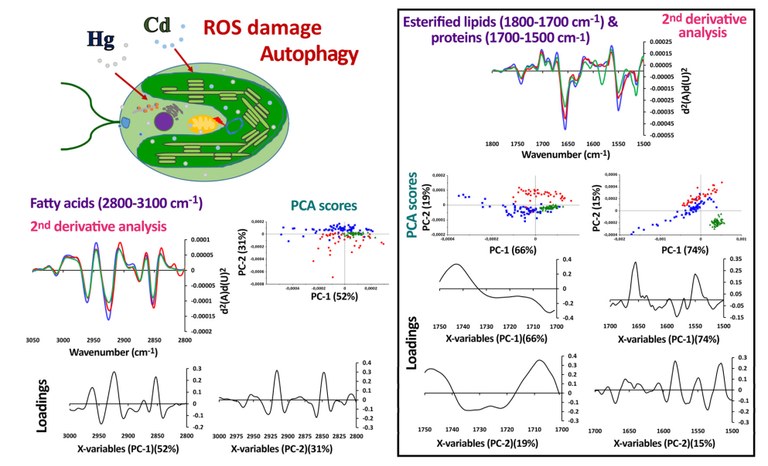
Electron transmission microscopy of Chlamydomonas reinhardtii cells to show alterations caused by cadmium and mercury. The pyrenoid (p) looks aberrant, with proliferation of lipid vesicles (green arrowhead) and starch grains (s). Metals also triggered the appearance of autophagy vesicles (red arrowhead). Right: image of Chlamydomonas reinhardtii (Wikimedia Commons).
Cerdanyola del Vallès, 25 August 2021 Contamination by metals like cadmium or mercury is considered a serious threat to the environment and human health. Several human activities such as mining, metallurgy industry, and extensive use of mineral fertilizers are the main sources of ongoing metal pollution in numerous ecosystems. This environmental risk is potentiated by bioaccumulation and trophic chain biomagnification phenomena, which are associated with the long persistence of toxic metals in the polluted ecosystems. Aquatic and soil ecosystems affected by runoffs loaded with toxic metals are particularly vulnerable, where primary producers photosynthetic organisms (phytoplankton and soil microalgae) represent the first stage of pollution build-up. Knowledge about mechanisms of toxicity in these organisms is essential for appropriate assessment of environmental risks.
Researchers from the Plant Physiology Laboratory of the Department of Biology, also affiliated with the Research Centre for Biodiversity and Global Change, at the Autonomous University of Madrid (UAM), have discovered the major changes of biomolecules caused by cadmium and mercury in the model green microalga Chlamydomonas reinhardtii.
The use of synchrotron technology at MIRAS beamline was a valuable tool and has made it possible to analyze in detail variations in the biomolecular pattern caused by heavy metals at levels of resolution rarely described before. “Among the cellular components that readily changed upon metal treatments, we detected alterations in the lipid composition by synchrotron light infrared spectroscopy at ALBA, which corresponded to accumulation of neutral lipids and increased fatty unsaturation” specifies Ángel Barón, scientist at UAM.
Each metal triggered a specific response pattern, information that is relevant to understand the mechanisms of toxicity induced. Under cadmium exposure, there was specifically higher unsaturation of free fatty acids, while mercury led to stronger unsaturation in monogalactosyldiacylglycerol.
Scientists have also observed that the chloroplast was a particularly vulnerable organelle to the presence of these metals that altered basic functions such as photosynthesis.
The high descriptive level of this study spotlights the relevance of the results obtained, which will allow progress in the design and development of new technologies in the field of decontamination of toxic metals and bioremediation of aquatic and soil ecosystems.
Synchrotron light to decipher the effects of metal pollutants
Samples of microalgae were exposed to toxic metals, cadmium or mercury, at different concentrations and for different intervals. They were subjected to analysis by FTIR (Fourier Transform Infrared) spectroscopy coupled to synchrotron light (SR-FTIR) in order to obtain their characteristic absorption spectra. The results on the MIRAS beamline showed multiple variations in the biomolecular profile of the algae that matched complementary observations and results obtained in scientists home laboratory at UAM, where they detected the high level of oxidative stress generated by those toxic metals.
The research team from Madrid continues studying the effects of metals in photosynthetic organisms. Other SR-FTIR analyses are currently being carried out in ALBA's MIRAS beamline to determine the responses of microalgae exposed to another metalloid pollutant (arsenic) and its relationship with phosphorus levels. “It should be noted that arsenic contamination of water affects a large part of the world's population and poses a serious risk to human health”, explains Ángel Barón.
On the other hand, the biomolecular alterations produced by mercury, cadmium and arsenic in crop plants such as wheat and alfalfa are also being evaluated in order to understand the detoxification mechanisms and propose the development of new phytoremediation techniques. In this sense, the research group of Dr. Luis E. Hernández at the Biology Department of the UAM has extensive experience in the field of the response of photosynthetic organisms (plants and algae) to oxidative stress generated by toxic metals and metalloids.

Examples of SR-FTIR spectra collected at different regions are showed, with statistical Principal Component Analysis and loadings to determine changes in specific functional groups of biomolecules.
Reference: Ángel Barón-Sola, Margarita Toledo-Basantes, María Arana-Gandía, Flor Martínez, Cristina Ortega-Villasante, Tanja Dučić, Ibraheem Yousef, Luis E. Hernández. Synchrotron Radiation-Fourier Transformed Infrared microspectroscopy (μSR-FTIR) reveals multiple metabolism alterations in microalgae induced by cadmium and mercury. Journal of Hazardous Materials (2021). Volume 419, 126502. ISSN 0304-3894. https://doi.org/10.1016/j.jhazmat.2021.126502.
With the collaboration of Fundación Española para la Ciencia y la Tecnología. The ALBA Synchrotron is part of the of the Unidades de Cultura Científica y de la Innovación (UCC+i) of the FECYT and has received support through the FCT-20-15798 project.





